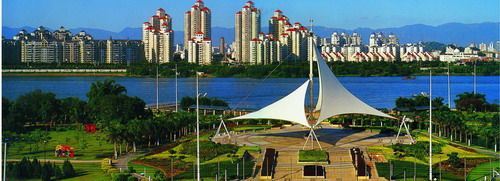


Language
A majority of Fujian’s people speak Mandarin, which has been the medium of education in China since the 1950s and is the main language in Fujian. The province does, however, have many of its own dialects. The terrain is mountainous and, at one time, nearly every valley had its own language. These dialects often carry the prefix "Min", for Fujian, and include Minnan (southern Min), Mindong (eastern), Minbei (northern), and Minzhong (central), along with Puxian (for Putian city, Xian county). The dialects are not mutually intelligible, though they do share certain common features, with the "Min" group generally considered the most different of all Chinese dialects from standard Mandarin. One of the most important is Minnan, which is spoken in Xiamen, Quanzhou, Zhangzhou, and surrounding areas. Many Taiwan people speak the same dialect. In Malaysia and Singapore, the same language is called Hokkien (Minnan, for Fujian). The Mindong or Fuzhou hua (Fuzhou speech), is spoken in Fuzhou, with a large number of speakers in northern coastal areas. The Hakka (or kejia客家) people in western Fujian have their own language.

Music
Fujian’s traditional music includes a variety of folk and classical styles, one of which, Nanyin dates back to the period between the Sui and Tang eras, in the 7th century. Quanzhou was a major city then, on an important maritime trade route, which brought distant cultures to the city. The result was what is now known as nanyin/nanguan music, which is regarded as a "living fossil" of classical Chinese music. The cities of Xiamen and Quanzhou have applied to UNESCO for recognition for their heritage. Fujian also has 24 types of traditional opera, including Min (Fuzhou), Xiang (Zhangzhou), Liyuan, Gaojia (Quanzhou), and Puxian (Putian), as well as Han opera and puppet shows.
Cuisine
Fujian cuisine has plenty of seafood and is one of China’s major cuisines, with various traditions. One of the most famous dishes is Fotiaoqiang (Buddha jumping over the wall), a mixture of many ingredients, such as shark fin, sea cucumbers, abalone, and Shaoxing wine. The province’s handicrafts include Shoushan stone (a translucent stone) carving of numerous types, lacquer ware, Long'an wood carving, ivory and jade carving, paper umbrellas, and ox horn combs, all of which are popular at home and abroad.
Religions
The province has five major religions: Buddhism, Taoism, Islam, Roman Catholic, and Protestantism, with the number of believers being around 1.1 million. It has 6,072 religious sites. Its Buddhist temples and number of monks and nuns put it in first place among all Han areas, with 14 Buddhist temples with State Council certification, or 10 percent of the total in Han areas. The province also has 267 religious groups and three institutions -- the Fujian Buddhist Academy, Fujian Theological Seminary, and Minnan regional Buddhist Academy -- with a total of 600 students. There are also more than 20,000 sites for folk activities. Fujian also has a higher number of Muslims than most parts of southern China thanks to its history of maritime trade, as well as quite a few Christians, because it was a focus of 19th century missionary activities.